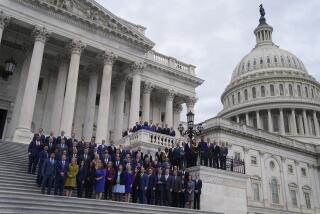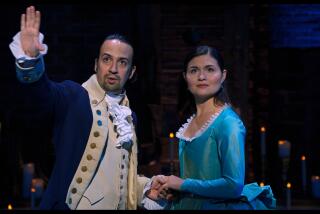Fourth of July: Where to celebrate being an American
You’ll probably grill a hot dog, watch some fireworks and, perhaps, think about the wonders of being an American. One of them is our freedom to see this country. In thinking about the Fourth of July, we’ve assembled a list of some of the places we think will make you remember what it is to be an American -- a hot-dog-eating, apple-pie-chomping, optimistic sort who learns from the past in order to face the future head on.
A bit pie-eyed
Thank goodness Harvard grad Samuel Sewall thought to record something as mundane as his first bite of “applepy.” His diary entry of 1697 qualifies as the first American mention of apple pie, according to “America in So Many Words: Words That Have Shaped America.” The expression “as American as apple pie,” which links the sweet stuff with patriotism, wouldn’t come into vogue until hundreds of years later, in the 1960s.
Still, apple pie wasn’t invented in this country. I wouldn’t tell that to folks in the mountain town of Julian, Calif., which has cultivated its reputation -- and a good bit of tourism -- with apples. The Julian Pie Co. (2225 Main St. (760) 765-2449), for example, began when Liz Smothers became smitten with baking apple pies. In 1989, she and her husband, Keith, planted 17,000 apple trees just to supply her pie-making habit. Now they ship fresh pies -- original (made with Granny Smiths), Dutch apple, boysenberry apple, peach apple and other combinations -- all over the U.S.
In fall, I like to tour Julian’s apple orchards and pick fruit, take a carriage ride through town or hoist a glass of cider or two. For the Fourth of July, it’s hot, so the town skips fireworks (because of fire danger) and puts on a snazzy hometown parade at noon. And I’m sure there’s always a slice of pie to be found somewhere in town. For information on Julian’s parade, click here.
-- Mary Forgione
To the dogs
First of all, Dodger Dogs may be the most overrated food item in America, as limp as a piece of asparagus. Pink’s is merely a pretender. In Chicago, they’d burn an ordinary place like that to the ground. Who let these dogs out?
I don’t know that any single ingredient makes a proper Chicago-style dog what it is. Rather, it’s the symphony of flavors and textures that make it sing: the dill spear, the nuclear-green relish, the chopped tomato, the celery salt, a hot pepper, all of it pillowed into a magnificent poppy seed bun. In my book, the best Chicago joint is Superdawg (6363 N. Milwaukee). At this retro landmark, the dog has snap, and the poppy seed bun is super fresh. At $5.50, it’s a little on the steep side, as Chicago dogs go. But worth every penny.
Hot Doug’s (3324 N. California) is also worth a stop, serving a dressed Chicago-style dog for $2. Makes you proud to be an American, doesn’t it? (Note that Hot Doug’s is closed on July 4.)
-- Chris Erskine
The man from IndependenceWhat could be more perfect for the Fourth of July than a town called Independence? Perhaps a town called Independence that was home to a president.
To visit Independence, Mo., is to remember that no matter how far down you are, life can turn around. And to know that mental toughness is as all-American as that Julian apple pie.
One clarification here: Harry Truman wasn’t born in Independence, which is about 15 miles from downtown Kansas City, Mo. Instead, Truman’s life began on May 8, 1884, in the town of Lamar, Mo., about 125 miles almost directly south of Independence. But he spent much of his growing-up years in Independence, and it was there that he met Bess Truman (who, by the way, turned him down the first time he proposed, suggesting again that resilience is an important trait)
After serving in World War I, Truman and a colleague opened a haberdashery business in Kansas City. It failed. But politics beckoned., and by 1934, he was running for (and winning) a seat in Congress. In 1944, he replaced Henry Wallace as the vice presidential candidate under Franklin D. Roosevelt and was sworn in Jan. 20, 1945.
Roosevelt died on April 12, 1945, leaving the country in the hands of a man who had been reluctant to assume the vice presidential post, never mind the presidency.
His terms were fraught with difficulties, and when he left office, he was one of the most unpopular presidents (“To err is Truman” was a popular saying), but history has been kinder to him.
Returning to Independence must have been a relief. The town, the starting point of the Santa Fe, Oregon and California trails, is home to numerous Truman sites. There’s the Harry S. Truman Library and Museum, one of 13 presidential libraries in the United States. He and Bess Truman are buried there. To tour the library is to understand the struggles of our 33rd president: his decision to drop the atomic bomb to end World War II; the beginnings of the Cold War; the recognition of Israel. All are part of an ongoing 10,500-square-foot exhibit that has audio, visual and interactive elements. Another exhibition, which will continue through Dec. 31, traces the history of his family.
Harry S. Truman Library and Museum; 500 W. U.S. Highway 24; (816) 268-8200 or (800) 833-1225. Admission: $8 for adults, $7 for seniors 65 and older; $3 for children 6-15.
You can also feel the spirit of Independence (and Truman) at the Truman home at 219 N. Delaware (tours every 15 minutes), a National Historic Site, and at Clinton’s Soda Fountain, 100 N. Maple, where Truman is said to have had his first job.
For more info on Independence, go to VisitIndependence.com
-- Catharine Hamm
Remember to vote
The next time you think it’s just too much trouble to vote, think about Selma, Ala., home of the National Voting Rights Museum and Institute.
Selma, you’ll recall, is the site of the Edmund Pettus Bridge, where 600 civil rights marchers were attacked, beaten and tear-gassed as they began their walk to Montgomery, 54 miles away, to ask for changes in the voter-registration process.
That was March 7, 1965, which came to be known as Bloody Sunday. On March 21, with protection from state and federal authorities, the marchers began again, and the march was completed on March 25. Martin Luther King Jr. addressed the crowd. The Voting Rights Act, passed in May 1965, struck down many of the obstacles that kept African Americans from voting.
So it’s only fitting that the National Voting Rights Museum and Institute was established in Selma to explain what happened and why through exhibits and photographs, and to help ensure it never has to happen again.
National Voting Rights Museum and Institute, U.S. Highway 80 East, Selma, Ala.; (334) 418-0800. Admission $6.50 for adults, $6.50 for students and those 55 and older.
-- Catharine Hamm
American by choice
For about 12 million immigrants, including both sets of my grandparents, Ellis Island (which is in both New York and New Jersey) was the place where becoming an American began. It’s hard to imagine that, between 1892 and 1954, the cavernous Main Hall that tourists now shuffle through once bulged with new arrivals.
It isn’t easy to grasp all that went on at the immigration station turned national monument. Visiting means reading stories and ships’ passenger logs, but what better place to contemplate what it means to be an American? A good place to start is by watching the documentary “Island of Hope, Island of Tears.” Then spend time at the exhibitions, currently including one on Detroit’s immigrants who arrived before World War I, and another on those who came from Central Europe starting in 1880.
For visitors, part of the island’s story is missing. The hospital complex where many immigrants were quarantined or even died is among 29 buildings that have been left abandoned for decades. Last month, the National Trust for Historic Preservation placed these buildings on its most endangered historic places list, citing lack of funding as the reason they remain unrestored.
-- Mary Forgione
More to Read
Sign up for The Wild
We’ll help you find the best places to hike, bike and run, as well as the perfect silent spots for meditation and yoga.
You may occasionally receive promotional content from the Los Angeles Times.









